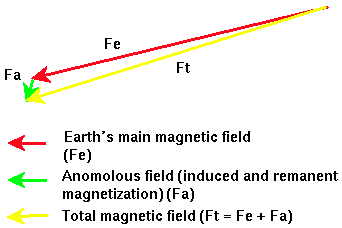Total Field Measurements
Given the ease of use of the proton precession magnetometer, most exploration geophysical surveys employ this instrument and thus measure only the magnitude of the total magnetic field as a function of position. Surveys conducted using the proton precession magnetometer do not have the ability to determine the direction of the total field as a function of location.

Ignoring for the moment the temporally varying contribution to the recorded magnetic field caused by the external magnetic field, the magnetic field we record with our proton precession magnetometer has two components:
- The main magnetic field, or that part of the Earth's magnetic field generated by deep (outer core) sources. The direction and size of this component of the magnetic field at some point on the Earth's surface is represented by the vector labeled Fe in the figure.
- The anomalous magnetic field, or that part of the Earth's magnetic field caused by magnetic induction of crustal rocks or remanent magnetization of crustal rocks. The direction and size of this component of the magnetic field is represented by the vector labeled Fa in the figure.
Typically, Fe is much larger than Fa, as is shown in the figure (50,000 nT versus 100 nT). If Fe is much larger than Fa, then Ft will point almost in the same direction as Fe regardless of the direction of Fa. That is because the anomalous field, Fa, is so much smaller than the main field, Fe, that the total field, Ft, will be almost parallel to the main field.